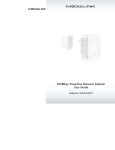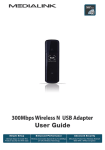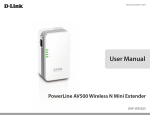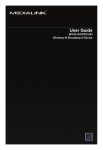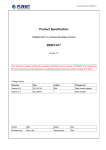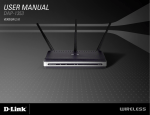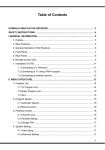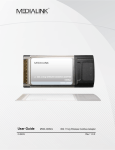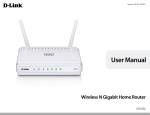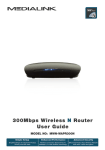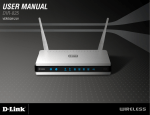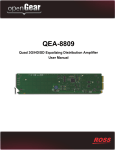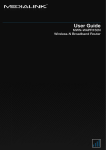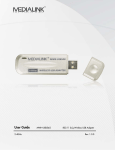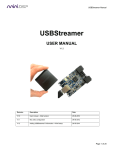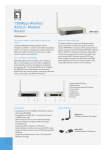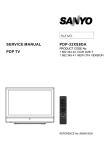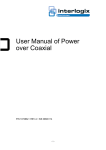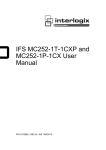Download 目 录 - wireless driver
Transcript
Wireless N USB Adapter - User Guide Copyright Statement is a registered trademark of Medialink Products, LLC. All products and product marks mentioned herein are the trademarks or registered trademarks of their respective holders. Copyright of the entire product, including its accessories and software, belongs to Medialink Products, LLC. No individual or party is permitted to copy, plagiarize or imitate this product without the expressed written consent of Medialink Products, LLC. All the photos and product specifications mentioned in this guide are for references only. As there may be future upgrades to software and hardware, Medialink Products cannot be not be responsible for informing users about changes to this product or its software. For more information, visit our website at www.medialinkproducts.com . -1-|P a g e Wireless N USB Adapter - User Guide FCC STATEMENT This equipment has been tested and found to comply with the limits for a Class B digital device, pursuant to part 15 of the FCC Rules. These limits are designed to provide reasonable protection against harmful interference in a residential installation. This equipment generates, uses and can radiate radio frequency energy and, if not installed and used in accordance with the instructions, may cause harmful interference to radio communications. However, there is no guarantee that interference will not occur in a particular installation. If this equipment does cause harmful interference to radio or television reception, which can be determined by turning the equipment off and on, the user is encouraged to try to correct the interference by one or more of the following measures: • • • Reorient or relocate the receiving antenna. Increase the separation between the equipment and receiver. Connect the equipment into an outlet on a circuit different from that to which the receiver is connected. • Consult the dealer or an experienced radio/ TV technician for help. This device complies with part 15 of the FCC Rules. Operation is subject to the following two conditions: This device may not cause harmful interference. This device must accept any interference received, including interference that may cause undesired operation. Any changes or modifications not expressly approved by the party responsible for compliance could void the user’s authority to operate the equipment. 1) 2) FCC RF Radiation Exposure Statement This device has been tested for compliance with FCC RF Exposure (SAR) limits in the typical laptop computer configuration and this device can be used in desktop or laptop computers with side mounted PCMCIA slots. This device cannot be used with handheld PDAs (personal digital assistants). This device and its antenna must not be co-located or operated in conjunction with any other antenna or transmitter. CE Mark Warning This is a class B product. In a domestic environment, this product may cause radio interference, in which case the user may be required to take adequate measures. -2-|P a g e Wireless N USB Adapter - User Guide Table of Contents COPYRIGHT / FCC STATEMENT .................. 1-2 TABLE OF CONTENTS ............................. - 3 INTRODUCTION .........................................4 PRODUCT FEATURES ...................................5 PACKAGE CONTENTS ..................................5 INSTALLATION GUIDE .................................6 INSTALL SOFTWARE ...................................7 CLIENT UTILITY INTERFACE ........................ 11 STATION MODE ....................................... 11 Station Mode Topology.......................... 11 STATION MODE - “STATUS” TAB................... 12 STATION MODE - “SITE SURVEY” TAB ............ 13 STATION MODE - “PROFILE MANAGEMENT” TAB 14 STATION MODE - “STATISTICS” TAB .............. 15 STATION MODE - “WPS SETTING” TAB .......... 16 AP MODE – GENERAL INFO ........................ 17 AP MODE - BASIC SETTING ........................ 18 AP MODE - SECURITY SETTING ................... 19 AP MODE - ACCESS CONTROL ..................... 20 AP MODE - ABOUT TAB ............................ 21 Appendix One: Acronyms and Terms ........ 22 Appendix Two: Product Specification ........ 23 Appendix Three: How to connect with PSP…24 -3-|P a g e Wireless N USB Adapter - User Guide Introduction Your Medialink MWN-USB150N utilizes the latest standard in wireless networking technology, 802.11n (Draft 2.0). This state of the art standard increases transmission range, increases throughput and reduces “dead spots”. This adapter was carefully designed to make installation as simple as possible. In most cases, even the most novice user will complete installation within just a few minutes. WPS (Wi-Fi Protected Setup) simplifies password entry and frees you from having to remember long passwords. Support for PSP, NDS and WII connections with Xlink Kai allows for a rich on-line gaming experience. The Medialink MWN-USB150N is a high performance Wireless N USB Adapter with improved range, faster throughput and state of the art security. 4|P a g e Wireless N USB Adapter - User Guide Product Features • • • • • • • • • • • • • • EZ Install – Simplified Installation via Graphical User Interface. Microsoft WHQL Certification ensures compatibility with Windows OS. Supports Windows 2000, XP, Vista 32-Bit, Vista 64-bit, Linux & MAC. Complies with 802.11n (Draft 2.0), 802.11g and 802.11b standards. High Speed USB 2.0 port, backward compatible with USB1.0. 150Mbps maximum send/receive throughput. Supports 20MHz/40MHz frequency bandwidth. Auto-detects network transmission rate. Provides Both Infrastructure and Ad-Hoc mode. Supports Soft AP to Quickly Establish Wireless LAN Networking. Supports PSP, WII, NDS with Xlink Kai for on-line gaming. Supports 64/128-bit WEP, WPA, WPA2 encryption methods and 802.1x security authentication standard. Supports WPS (Wi-Fi Protected Setup) encryption method to eliminate the need to remember long passwords. Supports WMM to make voice and video as smooth as possible. Package Contents Unpack the contents of your USB Adapter, and locate the following items: Wireless USB Adapter USB Seat Installation CD Quick Installation Guide 5|P a g e Wireless N USB Adapter - User Guide Installation Guide *IMPORTANT NOTE* - DO NOT INSERT YOUR MEDIALINK WIRELESS USB ADAPTER INTO YOUR COMPUTER USB PORT UNTIL AFTER THE SOFTWARE IS INSTALLED. Please follow the simple steps in this Guide to get your computer quickly connected to your wireless network. Before you begin, please be sure you have the following: PC with an available USB slot Minimum 300MHz processor and 32MB memory Windows 2000, XP, Vista 32-bit, Vista 64-bit (For Linux or MAC instructions, please refer to “USER MANUAL” on the installation CD). An 802.11n, 802.11g or 802.11b Access Point or Router 6|P a g e Wireless N USB Adapter - User Guide Install Software STEP 1. Insert CD into an available CD-ROM drive. NOTE: The following Screen shots illustrating the installation procedure are from a Windows XP installation. Other operating systems may show slightly different dialogue boxes but the installation procedures will be the same. STEP 2. 7|P a g e Click Install Software Wireless N USB Adapter - User Guide STEP 3. Click Next to start installation. STEP 4. Click Next to continue. (Installation may take a few minutes. Please wait.) 8|P a g e Wireless N USB Adapter - User Guide STEP 5. Click Finish to complete the software installation. STEP 6. Insert the USB Adapter into an available USB slot. Please wait while hardware drivers are installed. (For Windows 2000 & Windows Vista you will be prompted to restart your computer) 9|P a g e Wireless N USB Adapter - User Guide STEP 7. Connect to your network You will see a tray icon appear in your system tray at the bottom of the screen after the software and hardware installation are completed successfully. to launch the configuration utility. STEP 8. Double-click the tray icon STEP 9. Click on the SITE SURVEY tab. STEP 10. Select your network and click CONNECT. Note - If your router has security enabled, please insert your router password and wait for your router authentication. The tray icon will turn green to indicate communication with the router. CONGRATULATIONS! You’re Medialink adapter is now successfully connected to your wireless network. 10 | P a g e Wireless N USB Adapter - User Guide Chapter 3 Client Utility Interface The Medialink configuration utility is used for management of the Medialink MWN-USB150N to launch the Wireless USB Adapter. To access it’s features, double-click the tray icon configuration utility. If the tray icon is not present, Click “Start”, “All Programs” “Medialink” and finally “MWN-USB150N”; or click the Medialink shortcut on your PC’s desktop. Note: With Windows XP, users can select either the Medialink Client Utility Interface or the Windows XP internal wireless application to configure and manage the Medialink MWN-USB150N wireless adapter. There are two client utility applications available from the Medialink Client Utility Interface: Station mode and AP mode. Note: Station Mode is the default mode and is the best mode to use when connecting to a wireless router. Station Mode Station Mode Topology In Station Mode, the MWN-USB150N serves as a wireless client to receive wireless signals from a wireless router in order to access the Internet. 11 | P a g e Wireless N USB Adapter - User Guide Station Mode - “Status” Tab When the “STATUS” tab is selected, the wireless network status, SSID, Authentication type, Encryption Type, IP address, subnet mask and gateway are displayed. 12 | P a g e Wireless N USB Adapter - User Guide Station Mode - “Site Survey” Tab The “SITE SURVEY” tab is used to scan and display the available wireless networks. The signal strength of the available networks along with the encryption type will also be displayed. Click Connect: to select and connect to the desired network. Click Refresh: to rescan for available wireless networks. 13 | P a g e Wireless N USB Adapter - User Guide Station Mode - “Profile Management” Tab The “PROFILE” tab allows you to save multiple profiles for quick connection to various networks. Click UP/DOWN: To change a profile’s sequence in the list. Click Connect: To activate an existing profile. Click New: To create a new profile and configure the site status and security setting. Click Modify: To modify an existing profile. Click Delete: To delete an existing profile. 14 | P a g e Wireless N USB Adapter - User Guide Station Mode - “Statistics” Tab The “STATISTICS” tab is used to display Rx and Tx data packets, including the success and error packet amount. Click Clear: to refresh the statistics. 15 | P a g e Wireless N USB Adapter - User Guide Station Mode - “WPS Setting” Tab The WPS is available only when used with WPS-compliant routers. PIN: Enter the Pin code and click “PIN” to automatically connect the wireless adapter to available networks. PBC: Click “PBC” to auto-check available connections. Refresh: To update the Pin code. Rescan: To rescan for available WPS-compliant wireless networks. Connect: To connect the WPS wireless network. Disconnect: To disconnect from the current connected wireless network. 16 | P a g e Wireless N USB Adapter - User Guide AP Mode – General Info In cases where wireless access to an Ethernet network is desired, the Medialink MWN-USB150N can serve as an access point to transmit wireless signals and to allow other wireless clients to access the network. Note: AP Mode does not take the place of a router or modem which is required for internet access. AP Mode Topology 17 | P a g e Wireless N USB Adapter - User Guide AP Mode - Basic Setting This window is used to configure the AP’s basic parameters, including SSID, Wireless Mode and Channel. SSID: Here you can give your AP a Wireless Network ID name (SSID). Wireless Mode: Here you can set the AP to operate at 802.11b, 802.11g, or 802.11b/g/n mixed. Channel: 1~11 channels provided. Restore Default: to restore the set parameters to default factory default settings. Apply: to make the changes made take effect. 18 | P a g e Wireless N USB Adapter - User Guide AP Mode - Security Setting This window is used to configure the wireless network’s security authentication, providing WEP, WPA-PSK, WPA2-PSK, and WPA-PSK/WPA2-PSK encryption methods. WEP:10/26 bits Hex or 5/13 ASCII support. WPA-PSK:8~32 bits ASCII support. WPA2-PSK:8~32 bits ASCII support. WPA-PSK/WPA2-PSK:8~32 bits ASCII support. Note: 1. The Hex characters include 0~9 numbers and a~f letters. 2. ASCII characters include any numbers/letters and characters. 19 | P a g e Wireless N USB Adapter - User Guide AP Mode - Access Control Access Control uses client MAC addresses to allow or disallow access to the network. Filter Policy: Disabled: Disables the filter function. All Permitted: Permits all clients in the list to access the wireless network. All Blocked: Blocks all clients in the list from access to the wireless network. MAC Address:Input the client’s MAC address to implement the corresponding filter policy. Add: Adds the entered MAC address into the list. Delete: Deletes one selected MAC address in the list. Remove All: Deletes all listed client MAC addresses. Apply: Makes the changes take effect. 20 | P a g e Wireless N USB Adapter - User Guide AP Mode - About TAB This window displays details about the software version and wireless adapter. 21 | P a g e Wireless N USB Adapter - User Guide Appendix One: Acronyms and Terms WLAN Wireless Local Area Network 802.11 A family of specifications developed by the IEEE for WLAN technology. 802.11a An extension to 802.11 WLAN standard that provides up to 54 Mbps transmis- sion in the 5 GHz UNI radio band. 802.11b An extension to 802.11 WLAN standard that provides up to 11 Mbps transmission in the 2.4 GHz ISM radio band. 802.11b uses DSSS modulation. 802.11g An extension to 802.11 WLAN standard that provides up to 54 Mbps transmission in the 2.4 GHz ISM radio band. 802.11b uses OFDM modulation and is backwards compatible with 802.11b. Ad-Hoc A group of computers each with wireless adapters, connected as an independent WLAN. AES Advanced Encryption Standard BSSID Basic Service Set ID DHCP Dynamic Host Configuration Protocol DSSS Direct Sequence Spread Spectrum. DSSS is one of two types of spread spectrum radio. The other is frequency-hopping spread spectrum (FHSS). QoS Quality of Service OFDM Orthogonal Frequency Division Multiplexing RADIUS Remote Authentication Dial In User Service RTS Request to Send SSID Service Set Identifier. A 32-character unique identifier attached to the header of packets sent over a WLAN that acts as a password when a mobile device tries to connect to the BSS. TCP/IP Transmission Control Protocol/Internet Protocol TKIP Temporal Key Integrity Protocol WDS Wireless Distribution System WEP Wired Equivalent Privacy. A security protocol for WLANs defined in the IEEE 802.11 standard. WPA Wi-Fi Protected Access WPA2 Wi-Fi Protected Access 2. The next generation of Wi-Fi security, based on the 802.11i standard. WPA2-PSK Wi-Fi Protected Access 2-Pre-shared Keys WPA-PSK 22 | P a g e Wi-Fi Protected Access-Pre-shared Keys Wireless N USB Adapter - User Guide Appendix Two: Product Specification Standard IEEE802.11g, IEEE802.11b, IEEE802.11n Port USB2.0 Frequency Range 2.4GHz 130Mbps, 117Mbps, 104Mbps, 78Mbps, 52Mbps, 39Mbps, 26Mbps, 13Mbps, 65Mbps, 58.5Mbps, 52Mbps, 39Mbps, Transmission Rate 26Mbps, 19.5Mbps, 13Mbps, 6.5Mbps, 54 Mbps, 48 Mbps, 36 Mbps, 24 Mbps, 18 Mbps, 12 Mbps, 9 Mbps, 6 Mbps, 11 Mbps, 5.5 Mbps, 2 Mbps, 1 Mbps Transmission Power Max. 15dbm Modulation Method OFDM, CCK Working Temper. 0℃~40℃ Storage Temper. -40℃~70℃ Working Humidity 10%~90%RH non-condensing 23 | P a g e Wireless N USB Adapter - User Guide Appendix Three: How to connect with PSP 1. Topology of PSP connecting with MWN-USB56N 2. To configure PSP with Ad-Hoc mode 2.1 Select Network Settings 2.2 Select Ad-Hoc mode 2.3 Select Channel 24 | P a g e Wireless N USB Adapter - User Guide 3. In MWN-USB56N Utility Interface scan PSP and double-click to connect the wireless network. 4. Check “enable PSP connection mode” box. 25 | P a g e Wireless N USB Adapter - User Guide 5. To configure Xlink Kai Select “Start”→ “All programs” → “Xlink Kai Evolution VII” → “Start Kai Config” to configure the user name, password and other parameters as follows. 6. Login Xlink Kai Select “Start”→ “All programmers” → “Xlink Kai Evolution VII” → “Start Kai”. PSP will connect with Xlink Kai automatically. The following window will indicate the connection is established. 26 | P a g e Wireless N USB Adapter - User Guide Thank you for purchasing this Medialink product! Please contact us if you need any assistance with installation. We’ll be happy to help! Medialink Products, LLC 1951 Old Cuthbert Rd., Ste 301 Cherry Hill, NJ 08034-1411 Technical Support Hotline: Technical Support E-Mail: 27 | P a g e 856-216-8222 [email protected]




























